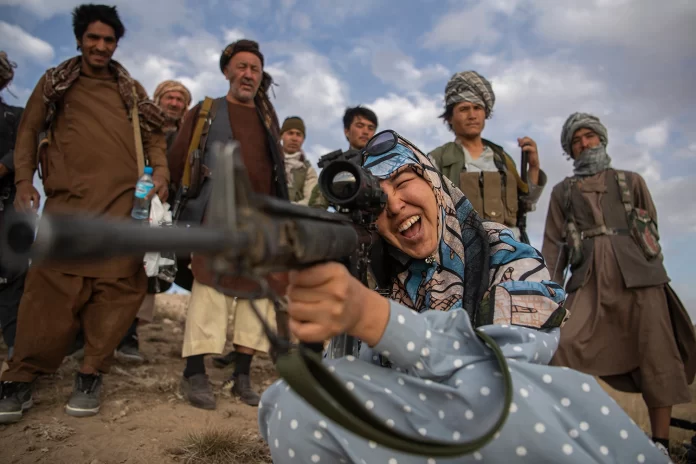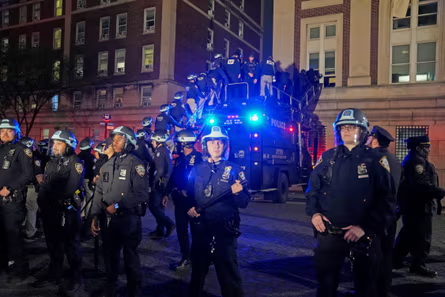A flood of arms, including many from former Afghan soldiers, threatens to spark more violence.
When the Afghan government collapsed last Aug. 15, Sardar, a 38-year-old Afghan major, could not believe that the institution he gave 12 years of his life to collapsed like a deck of cards. He’d dodged years of threats from insurgent groups and plenty of bullets—only to watch then-Afghan President Ashraf Ghani fly away and leave them all to the mercy of a vengeful Taliban.
The first thing Sardar (he asked not to use his full name for security reasons) did was take off the army uniform that placed a target on his back and stashed away his “Brita”—his government-issued Beretta M9 sidearm. “My pride was reduced to dust; all my dreams were gone at once. When I reached home, I couldn’t even tell my mother what I had done, stripping away my honor with the uniform,” he said.
The next three months were a blur, running from province to province to escape the Taliban’s vengeance. Meanwhile, with no income, he had no way to support his family. So he turned to the one thing he had left.
“My ‘Brita’ was the only remaining identity of my service to my country, but I had to sell it to feed my family,” he said. Through a friend, Sardar made contact with a local arms dealer and sold him the M9 for 60,000 afghanis (or about $680).
Sardar isn’t the only Afghan fighter who has put his weapons for sale on the black market, and security experts suspect that many former soldiers may have helped stock smugglers’ coffers with Western weapons and equipment. An Afghan weapons smuggler that Foreign Policy reached out to shared that never before in 20 years of black market trade had he made as many transactions with former members of the military.
“Most of my weapons in the last few months have come from former government forces, and American weapons are very lucrative and best-selling,” he said on the condition of anonymity in a phone interview. “Especially M4 carbines with cameras can go for as high as 250,000 afghanis while the M16 is priced between 70,000 and 75,000 [afghanis]. A British pistol costs 60,000 [afghanis].”
Many of these weapons though are finding their way to militant groups across the region. Indian security officials have shared concerns that a number of weapons— including M9 pistols, like those sold by Sardar—and equipment that belonged to the recently fallen Afghan army are showing up with militants in the Indian-administered Kashmir.
In recent encounters with insurgent groups, Indian security forces have recovered assault rifles along with steel core bullets that are capable of piercing body armor as well as Iridium satellite phones and night vision goggles, gear that was provided by the United States to the Afghan army before its collapse in August 2021. Similarly, recent videos by the many smaller terror outfits emerging in the valley show their militants using M249 automatic rifles, 509 tactical guns, M1911 pistols, and M4 carbine assault rifles—all U.S.-made weapons.
However, security analysts as well as former Afghan security officials said weapons sold by former soldiers are only a small fraction of the larger weapons smuggling occurring. The Taliban themselves captured a trove of U.S. armaments when they took over the country.
“What former [Afghan National Defense and Security Forces (ANDSF)] sold to smugglers is only a drop in the bucket and will likely be absorbed by the beleaguered domestic resistance against the Taliban. But what the Taliban can supply to ideologically aligned terrorist groups in the region is far more concerning,” said Ahmad Shuja Jamal, a former Afghan security official.
The U.S. Defense Department has estimated that “$7.12 billion worth of ANDSF equipment remained in Afghanistan in varying states of repair,” according to data shared with the U.S. Special Inspector General for Afghanistan Reconstruction. One Taliban official claimed that the group has secured more than 300,000 light arms, 26,000 heavy weapons, and about 61,000 military vehicles as spoils of war.
The Taliban, which have thrived off smuggling of other sorts, aren’t averse to arms-dealing, especially with fellow travelers. “The Taliban have an ideological affinity with these groups the same way that democracies tend to get along and support each other,” Jamal said. “The ascendance of other fundamentalist-militant groups will serve to affirm the Taliban’s model, so the regime in Afghanistan has an interest in supporting these groups across the region.”
“I am not surprised that U.S.-supplied weapons from Afghanistan, the vast bulk of which is now in Taliban custody, are going to militants elsewhere in the subcontinent,” he added.
Jonathan Schroden, director at CNA, a nonprofit research and analysis organization, echoed Jamal’s assessment. “It didn’t take much imagination to predict that this would happen,” he said. He, like Indian security officials, is concerned that the flood of weapons will find their way into new regional conflicts by arming groups like Jaish-e-Mohammed and Lashkar-e-Taiba, which have previously bloodied India with jihadi violence and could do so again.
“[The leadership is] very careful about not letting their weapons reach ISKP [the Islamic State-Khorasan Province], but they don’t care as much about other groups,” said an official from the former Afghan intelligence agency, warning that there was a high likelihood of these weapons being used in regional insurgencies in the coming months.
READ ALSO: Saudi: A Hajj closer to normal as 1 million Muslims begin pilgrimage
Although the recoveries of weapons made by Indian officials are, as yet, small in number, they have consistently increased over the last few months—as has the surge in militant violence in the disputed Kashmir Valley. While speaking at the Raisina Dialogue in April, Gen. Manoj Mukund Naravane, former chief general of the Indian Army, raised concerns over the “spillover” of weapons and militants from Afghanistan into the region.
“There is definitely an increase in the number of weapons and other equipment, especially night vision devices, that we are capturing or unearthing, which definitely have come from Afghanistan,” he said, drawing a comparison to the last time the Taliban were in control of Afghanistan in the mid-1990s.
“We did have a little spillover [during the last Taliban regime]. We had captured or killed Afghan terrorists [in Kashmir] also,” he said, adding that while there hasn’t yet been a surge in militants this time, “there is definitely a movement in that direction.”
Jamal warned that the Taliban’s takeover of Afghanistan has ideologically empowered regional militants. “It has served as a ‘proof of concept’ for other Islamist militant fundamentalist groups, who feel that it is possible to come to power or carve out territorial control using terrorism without incurring significant international censure,” he said.
Sardar, meanwhile, is painfully aware of the proliferation of Afghan weapons but isn’t sure where or with whom his beloved “Brita” is right now. “But I pray that my pistol never hurts an innocent,” he said.














